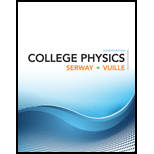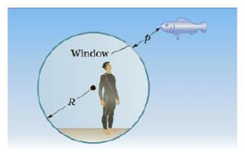
Bundle: College Physics, Loose-Leaf Version, 11th + WebAssign Printed Access Card for Serway/Vuille's College Physics, 11th Edition, Single-Term
11th Edition
ISBN: 9781337604888
Author: Raymond A. Serway, Chris Vuille
Publisher: Cengage Learning
expand_more
expand_more
format_list_bulleted
Concept explainers
Textbook Question
Chapter 23, Problem 26P
A man inside a spherical diving bell watches a fish through a window in the bell, as in Figure P23.26. If the diving bell has radius R = 1.75 m and the fish is a distance p = 1 00 m from the window, calculate (a) the image distance and (b) the magnification. Neglect the thickness of the window.

Figure P23.26
Expert Solution & Answer
Trending nowThis is a popular solution!

Students have asked these similar questions
No chatgpt pls
What is the current, in amps, across a conductor that has a resistance of10 Ω and a voltage of 20 V?
2. A conductor draws a current of 100 A and a resistance of 5 Ω. What is thevoltageacross the conductor?
3. What is the resistance, in ohm’s, of a conductor that has a voltage of 80 kVand acurrent of 200 mA?
4. An x-ray imaging system that draws a current of 90 A is supplied with 220V. What is the power consumed?
5. An x-ray is produced using 800 mA and 100 kV. What is the powerconsumed in kilowatts?
ՍՈՈՒ
XVirginia Western Community Coll x
P Course Home
X
+
astering.pearson.com/?courseld=13289599#/
Figure
y (mm)
x=0x = 0.0900 m
All
✓ Correct
For either the time for one full cycle is 0.040 s; this is the period.
Part C
-
ON
You are told that the two points x = 0 and x = 0.0900 m are within one
wavelength of each other. If the wave is moving in the +x-direction, determine the
wavelength.
Express your answer to two significant figures and include the appropriate
units.
0
t(s)
λ =
Value
m
0.01 0.03 0.05 0.07
Copyright © 2025 Pearson Education Inc. All rights
reserved.
日
F3
F4
F5
1775
%
F6
F7
B
F8
Submit
Previous Answers Request Answer
?
× Incorrect; Try Again; 3 attempts remaining
| Terms of Use | Privacy Policy | Permissions | Contact Us |
Cookie Settings
28°F Clear
4
9:23 PM
1/20/2025
F9
prt sc
F10
home
F11
end
F12
insert
delete
6
7
29
&
*
(
8
9
0
t
=
back
Ο
Chapter 23 Solutions
Bundle: College Physics, Loose-Leaf Version, 11th + WebAssign Printed Access Card for Serway/Vuille's College Physics, 11th Edition, Single-Term
Ch. 23.1 - In the overhead view if Figure 23.3, the image of...Ch. 23.3 - A person spearfishing from a boat sees a fish...Ch. 23.3 - True or False: (a) The image of an object placed...Ch. 23.5 - A clear plastic sandwich bag filled with water can...Ch. 23.5 - In Figure 23.25a, the blue object arrow is...Ch. 23.5 - An object is placed to the left of a converging...Ch. 23 - Tape a picture of yourself on a bathroom mirror....Ch. 23 - Prob. 2CQCh. 23 - The top row of Figure CQ23.3 shows three ray...Ch. 23 - Construct ray diagrams to determine whether each...
Ch. 23 - Construct ray diagrams to determine whether each...Ch. 23 - Prob. 6CQCh. 23 - Suppose you want to use a converging lens to...Ch. 23 - Lenses used in eyeglasses, whether converging or...Ch. 23 - In a Jules Verne novel, a piece of ice is shaped...Ch. 23 - If a cylinder of solid glass or clear plastic is...Ch. 23 - Prob. 11CQCh. 23 - Prob. 12CQCh. 23 - Why does the focal length of a mirror not depend...Ch. 23 - A person spear fishing from a boat sees a...Ch. 23 - An object represented by a gray arrow, is placed...Ch. 23 - (a) Does your bathroom mirror show you older or...Ch. 23 - Suppose you stand in front of a flat mirror and...Ch. 23 - Prob. 3PCh. 23 - In a church choir loft, two parallel walls are...Ch. 23 - A periscope (Fig. P23.5) is useful for viewing...Ch. 23 - A dentist uses a mirror to examine a tooth that is...Ch. 23 - A convex spherical mirror, whose focal length has...Ch. 23 - To fit a contact lens to a patient's eye, a...Ch. 23 - A virtual image is formed 20.0 cm from a concave...Ch. 23 - While looking at her image in a cosmetic minor,...Ch. 23 - Prob. 11PCh. 23 - A dedicated sports car enthusiast polishes the...Ch. 23 - A concave makeup mirror it designed to that a...Ch. 23 - A 1.80-m-tall person stands 9.00 m in front of a...Ch. 23 - A man standing 1.52 m in front of a shaving mirror...Ch. 23 - Prob. 16PCh. 23 - At an intersection of hospital hallways, a convex...Ch. 23 - The mirror of a solar cooker focuses the Suns rays...Ch. 23 - A spherical mirror is to be used to form an image,...Ch. 23 - Prob. 20PCh. 23 - A cubical block of ice 50.0 cm on an edge is...Ch. 23 - A goldfish is swimming inside a spherical bowl of...Ch. 23 - A paperweight is made of a solid hemisphere with...Ch. 23 - The top of a swimming pool is at ground level. If...Ch. 23 - A transparent sphere of unknown composition is...Ch. 23 - A man inside a spherical diving bell watches a...Ch. 23 - A jellyfish is floating in a water-filled aquarium...Ch. 23 - Figure P23.28 shows a curved surface separating a...Ch. 23 - A contact lens is made of plastic with an index of...Ch. 23 - A thin plastic lens with index of refraction n =...Ch. 23 - A converging lens has a local length of 10.0 cm....Ch. 23 - Prob. 32PCh. 23 - A diverging lens has a focal length of magnitude...Ch. 23 - A diverging lens has a focal length of 20.0 cm....Ch. 23 - Prob. 35PCh. 23 - The nickels image in Figure P23.36 has twice the...Ch. 23 - An object of height 8.00 cm it placed 25.0 cm to...Ch. 23 - An object is located 20.0 cm to the left of a...Ch. 23 - A converging lens is placed 30.0 cm to the right...Ch. 23 - (a) Use the thin-lens equation to derive an...Ch. 23 - Two converging lenses, each of focal length 15.0...Ch. 23 - A converging lens is placed at x = 0, a distance d...Ch. 23 - A 1.00-cm-high object is placed 4.00 cm to the...Ch. 23 - Two converging lenses having focal length of f1 =...Ch. 23 - Lens L1 in figure P23.45 has a focal length of...Ch. 23 - An object is placed 15.0 cm from a first...Ch. 23 - Prob. 47APCh. 23 - Prob. 48APCh. 23 - Prob. 49APCh. 23 - Prob. 50APCh. 23 - The lens and the mirror in figure P23.51 are...Ch. 23 - The object in Figure P23.52 is mid-way between the...Ch. 23 - Prob. 53APCh. 23 - Two rays travelling parallel to the principal axis...Ch. 23 - To work this problem, use the fact that the image...Ch. 23 - Consider two thin lenses, one of focal length f1...Ch. 23 - An object 2.00 cm high is placed 10.0 cm to the...Ch. 23 - Prob. 58APCh. 23 - Figure P23.59 shows a converging lens with radii...Ch. 23 - Prob. 60APCh. 23 - The lens-makers equation for a lens with index n1...Ch. 23 - An observer to the right of the mirror-lens...Ch. 23 - The lens-markers equation applies to a lens...Ch. 23 - Prob. 64APCh. 23 - A glass sphere (n = 1.50) with a radius of 15.0 cm...Ch. 23 - An object 10.0 cm tall is placed at the zero mark...
Knowledge Booster
Learn more about
Need a deep-dive on the concept behind this application? Look no further. Learn more about this topic, physics and related others by exploring similar questions and additional content below.Similar questions
- Part C Find the height yi from which the rock was launched. Express your answer in meters to three significant figures. Learning Goal: To practice Problem-Solving Strategy 4.1 for projectile motion problems. A rock thrown with speed 12.0 m/s and launch angle 30.0 ∘ (above the horizontal) travels a horizontal distance of d = 19.0 m before hitting the ground. From what height was the rock thrown? Use the value g = 9.800 m/s2 for the free-fall acceleration. PROBLEM-SOLVING STRATEGY 4.1 Projectile motion problems MODEL: Is it reasonable to ignore air resistance? If so, use the projectile motion model. VISUALIZE: Establish a coordinate system with the x-axis horizontal and the y-axis vertical. Define symbols and identify what the problem is trying to find. For a launch at angle θ, the initial velocity components are vix=v0cosθ and viy=v0sinθ. SOLVE: The acceleration is known: ax=0 and ay=−g. Thus, the problem becomes one of…arrow_forwardPhys 25arrow_forwardPhys 22arrow_forward
arrow_back_ios
SEE MORE QUESTIONS
arrow_forward_ios
Recommended textbooks for you
 College PhysicsPhysicsISBN:9781305952300Author:Raymond A. Serway, Chris VuillePublisher:Cengage Learning
College PhysicsPhysicsISBN:9781305952300Author:Raymond A. Serway, Chris VuillePublisher:Cengage Learning College PhysicsPhysicsISBN:9781285737027Author:Raymond A. Serway, Chris VuillePublisher:Cengage Learning
College PhysicsPhysicsISBN:9781285737027Author:Raymond A. Serway, Chris VuillePublisher:Cengage Learning Principles of Physics: A Calculus-Based TextPhysicsISBN:9781133104261Author:Raymond A. Serway, John W. JewettPublisher:Cengage Learning
Principles of Physics: A Calculus-Based TextPhysicsISBN:9781133104261Author:Raymond A. Serway, John W. JewettPublisher:Cengage Learning Physics for Scientists and Engineers: Foundations...PhysicsISBN:9781133939146Author:Katz, Debora M.Publisher:Cengage Learning
Physics for Scientists and Engineers: Foundations...PhysicsISBN:9781133939146Author:Katz, Debora M.Publisher:Cengage Learning Physics for Scientists and EngineersPhysicsISBN:9781337553278Author:Raymond A. Serway, John W. JewettPublisher:Cengage Learning
Physics for Scientists and EngineersPhysicsISBN:9781337553278Author:Raymond A. Serway, John W. JewettPublisher:Cengage Learning Physics for Scientists and Engineers with Modern ...PhysicsISBN:9781337553292Author:Raymond A. Serway, John W. JewettPublisher:Cengage Learning
Physics for Scientists and Engineers with Modern ...PhysicsISBN:9781337553292Author:Raymond A. Serway, John W. JewettPublisher:Cengage Learning

College Physics
Physics
ISBN:9781305952300
Author:Raymond A. Serway, Chris Vuille
Publisher:Cengage Learning

College Physics
Physics
ISBN:9781285737027
Author:Raymond A. Serway, Chris Vuille
Publisher:Cengage Learning

Principles of Physics: A Calculus-Based Text
Physics
ISBN:9781133104261
Author:Raymond A. Serway, John W. Jewett
Publisher:Cengage Learning

Physics for Scientists and Engineers: Foundations...
Physics
ISBN:9781133939146
Author:Katz, Debora M.
Publisher:Cengage Learning

Physics for Scientists and Engineers
Physics
ISBN:9781337553278
Author:Raymond A. Serway, John W. Jewett
Publisher:Cengage Learning

Physics for Scientists and Engineers with Modern ...
Physics
ISBN:9781337553292
Author:Raymond A. Serway, John W. Jewett
Publisher:Cengage Learning
Convex and Concave Lenses; Author: Manocha Academy;https://www.youtube.com/watch?v=CJ6aB5ULqa0;License: Standard YouTube License, CC-BY